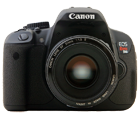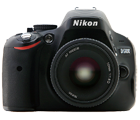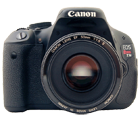Sony SLT-A77 Features

Available at Amazon, Adorama and B&H Photo Video
Introduction
The Sony SLT-A77 can't manage your finances, cook dinner or make voice-activated phone calls. That's OK — it can do just about everything else.
Every feature you could possibly imagine (plus a few that are hard to) is crammed inside the shell of the SLT-A77. It has a lesser sibling - the SLT-A65 - if you don't need the feature set, performance and price tag of the A77.
However, if you want a camera that can excel at portraits, landscapes, action, sports and wildlife photography, then the SLT-A77 is certainly one to consider.
Feature List
| Megapixels | 24.3 |
|---|---|
| Stabilization | In Body |
| Memory Card | SD / SDHC / SDXC |
| Max. Shutter Speed | 1/8000 |
| Max. Photo Capture | 12 per second |
| ISO Range | 100 to 16000 |
| Movie Modes | AVCHD 1920 x 1080 (60p, 60i, 24p) MP4 1440 x 1080 640 x 480 |
| LCD | Flexible 3in (921,600 dots) |
| Viewfinder | Electronic XGA OLED (2.36 million dots) |
| Autofocus | 19 point |
| Face Detect AF | Yes |
| Sensor Dimensions | 23.4 x 15.6 (1.5x crop factor) |
| HDMI Port | Yes |
| Live View | Yes |
| Built-in Flash | Yes |
| Compatible Lenses | All Sony ALPHA |
| Battery | NP-FM500H LiIon |
| Dimensions | 5.63 x 4.09 x 3.19in 143 x 104 x 81mm |
| Weight | 26oz (737g) |
New and Notable
There is so much that is notable about the A77 that it would take me more space than I have here to explain it all.
Instead, I will focus on some of the highlights that make the A77 a potential contender with the Big Two: Canon and Nikon.
Translucent Mirror
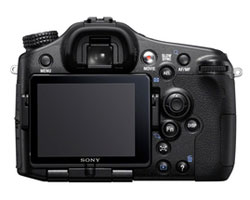
Inside the Sony SLT-A77 there is a special device called a translucent mirror. This special mirror takes the light that passes through the lens and divides it: some light goes to the camera's autofocus system while the rest is allowed to land on the sensor.
The whole point of this mirror is to allow for high-speed autofocus regardless of which mode the camera is in. Those who take pictures using the viewfinder will get the same speedy autofocus as those who use the camera's LCD.
You'll also get full-time continuous autofocus when the camera is in movie mode, so it will behave more like a consumer video camera and less like a professional film camera (where focus is done manually).
XGA OLED Viewfinder
The one drawback of the translucent mirror system is that the viewfinder must be electronic rather than optical.
Optical viewfinders have been used by SLRs for years: a system of mirrors inside the camera reflect light from the lens up to the viewfinder so that you see exactly what your lens sees.
The great thing about optical viewfinders is that you can move the camera quickly to track moving subjects and it's just the same as if you were watching the subject with your eyes.
Electronic viewfinders of the past always suffered from video delays: when you moved the camera fast, the image in the viewfinder would blur.
The new OLED viewfinder with its 2.36 million dots of information attempts to resolve this issue by creating an electronic viewfinder that's hard to tell apart from an optical one.
Flexible LCD
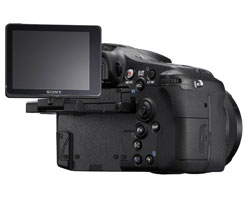
Flexible really doesn't adequately describe the 3 inch LCD screen on the back of the A77 — contortionist might be more appropriate.
While the LCD flips down from the bottom of the camera body like other Sonys with flexible LCDs, a second hinge lets you flip the LCD screen all the way up to the top of the camera.
This provides you with the ability to view the LCD when facing the front of the camera - a good thing for the photographer who's left out of family vacation photos.
Continuous Shot Speed
In continuous shot mode, a camera will keep taking photos one after the other so long as you keep your finger down on the shutter release button.
Conventional mirrors have to move out of the way of the sensor every time you take a picture so continuous shot speeds are limited to how fast the mirror can flap (6 per second is pretty fast).
The A77 suffers from no such limitation, and is capable of capturing shots at a rate of 12 per second.
In addition, it can continuously autofocus while it's taking shots, tracking a subject as it moves from side to side or toward the camera.
Sweep Panorama
The traditional method for creating panoramas is pretty laborious: lock your camera settings so they won't change, take several consecutive overlapping shots, then combine those shots using an image editing program to create the final panorama.
The A77 makes panoramas easier: just press and hold the shutter release and "sweep" the camera across the area you'd like to capture.
The camera captures the overlapping images and then assembles them - no additional computer required - into a single super-wide panoramic photo.
Built-in GPS
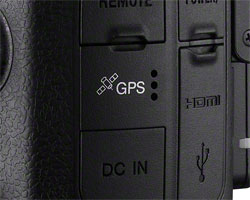
If you want to tag your photos with location data using other cameras you can — however, you have to purchase an extra GPS accessory that can cost several hundred dollars.
Not so with the A77 - the GPS is built in to the camera.
Now you can keep meticulous track of the longitude and latitude of every single shot you take. While this may sound like overkill, many photo organizing programs now provide a map feature.
GPS data can be used to automatically identify the location of your photos on a map without any extra tagging effort on your part.

|
